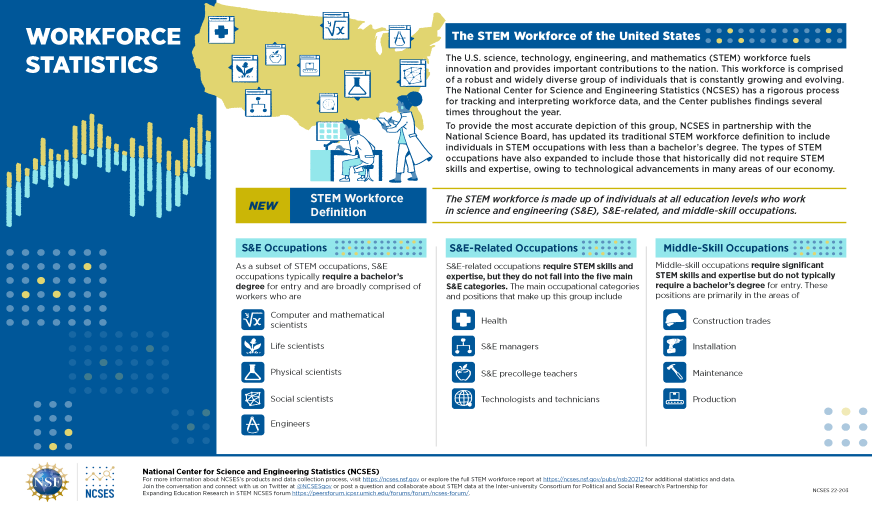Citizenship and race. Institutions in stage 1 provided combined citizenship and race data on the lists of early career doctorates to be used in stage 2 sample selection. Non-U.S. citizens were collected as a single group, and for U.S. citizens, a simplified 3-category race variable was collected, corresponding to the stage 2 sampling strata: Asian, White, and underrepresented minority.
Doctoral or doctorate degree. For this survey, the terms “doctoral degree” and “doctorate degree” were used interchangeably to refer to any kind of doctoral degree or international equivalent, aside from a juris doctor (JD) degree. Examples included PhD, EdD, DSc, MD, DO, DDS, DVM, and MBBS, among many others.
Early career doctorate. An individual who received their first doctoral degree between 1 July 2007 and 30 June 2017 and was working at one of the institutions selected for the survey during the week of 1 October 2017. The individual could have held any type of position (e.g., faculty, staff, postdoctorate, nonfaculty research) and received their doctoral degree from an institution in any country and in any discipline. All doctoral-level degrees were eligible (e.g., PhD, EdD, DSc, MD, DO, DDS, DVM, MBBS, and international equivalents), with the exception of JDs.
ECDS methodological study. From July 2012 through February 2013, NCSES conducted a methodological study with 81 institutions to test the feasibility of obtaining lists of early career doctorates and then sampling and surveying the early career doctorates based on these institutional lists.
ECDS pilot study. Conducted between July 2014 and March 2015, the pilot version of the survey involved 176 unique institutions and was designed to improve upon the methodology and initial study design for full scale data collection.
Federally funded research and development center (FFRDC). One of the three types of institutions included in the survey, an FFRDC is a unique type of nonprofit organization that is sponsored and funded by the U.S. government to meet a special long-term research or development need (https://www.nsf.gov/statistics/ffrdclist/).
Field of doctorate. The doctoral field is as specified by the respondent in the ECDS at the time of the survey, coded using classification of instructional program (CIP) codes. The CIP codes were subsequently recoded to the NCSES Taxonomy of Disciplines (ToD) used in the ECDS tables. See technical table A-3 for the crosswalk between the CIP codes and ToD fields used in the ECDS tables. The CIP-ToD crosswalk used to create these fields and to enable comparison among NCSES surveys is available upon request from NCSES.
Foreign doctorate degree. A respondent’s doctorate or equivalent was earned outside of the United States.
Postdoctoral researchers (postdocs). The definition of a postdoc varies by institution and individuals. Respondents were provided the following guidance: “For the purposes of this survey, a postdoctoral appointment, or “postdoc,” is a temporary position awarded in academe, industry, government or a non-profit organization primarily for gaining additional education and training in research.”
NCSES defines a postdoc as meeting both of the following qualifications:
- Holds a recent doctoral degree, generally awarded within the past 5 years, such as PhD or equivalent (e.g., ScD or DEng); a first professional degree in a medical or related field (MD, DDS, DO, DVM); or a foreign degree equivalent to a U.S. doctoral degree.
- Has a limited-term appointment, generally no more than 5–7 years, primarily for training in research or scholarship and working under the supervision of a senior scholar in a unit affiliated with the institution.
Race and ethnicity. Ethnicity is defined as Hispanic or Latino or not Hispanic or Latino. Values for those selecting a single race include American Indian or Alaska Native, Asian, Black or African American, Native Hawaiian or Other Pacific Islander, and White. Those persons who report more than one race and who are not of Hispanic or Latino ethnicity also have a separate value. Race and ethnicity were collected for all respondents, regardless of citizenship status.
Survey of Graduate Students and Postdoctorates in Science and Engineering (GSS). The GSS is an annual census of all U.S. academic institutions granting research-based master's degrees or doctorates in science, engineering, and selected health fields as of fall of the survey year. Eligible institutions offer at least one graduate program in science, engineering, or health. The GSS is sponsored by NCSES and by NIH.
Stage 1. Stage 1 of data collection involved working with a list coordinator at each institution to develop a list of early career doctorates to be used as a sampling frame.
Stage 2. Stage 2 of data collection involved inviting a sample of early career doctorates at each institution to participate in the Web-based ECDS to collect information about their academic and professional experiences.
Temporary visa holders. Individuals in the United States on temporary U.S. resident visas.
Underrepresented minorities (URMs). This category comprises three racial or ethnic minority groups (Blacks or African Americans, Hispanics or Latinos, and American Indians or Alaska Natives) whose representation in science and engineering education or employment is smaller than their representation in the U.S. population.
University-affiliated medical schools and centers. Medical schools, hospitals, or medical centers that were eligible for the GSS are affiliated with a university that was eligible for the GSS.
U.S. citizens and permanent residents. U.S. citizens, including those from Puerto Rico and the U.S. territories, and permanent residents holding permanent U.S. resident visas (Green Cards).
 An official website of the United States government
An official website of the United States government


